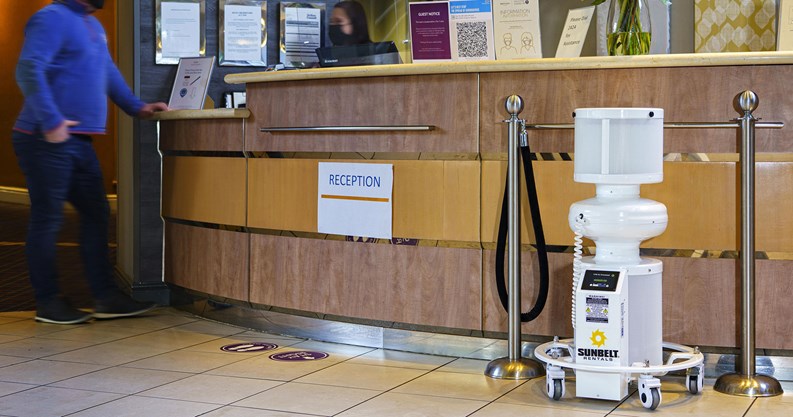Do Air Purifiers Kill Viruses?
blog 06 Jun 2022
Do air purifiers kill viruses? How do they work and what are the benefits of using them?
Since the COVID-19 pandemic, there has been increased interest in air purifiers as people look at how they can maintain their general wellbeing and improve indoor air quality.
In our latest blog we look at how air purifiers work, what benefits they bring and whether they can kill airborne viruses.
How do air purifiers work?
Air purifiers typically work by pulling the local air through a filter, or multiple filters. As air is passed through the filtration system, pollutants are captured and clean air is released back into the living or working space. Air purifiers come in all shapes and sizes - some are portable for use while travelling and others are much larger and are designed for offices, large spaces and healthcare and hospital settings. Not all air purifiers are the same and some use far more advanced technology than others.

Why should I use an air purifier?
Air purifiers have many different benefits and can be used for various reasons - such as reducing allergies, removing unpleasant odours, improving breathing by making the air cleaner and reducing the spread of airborne viruses and hospital-acquired infections (HAIs).
What the regulations say:
Updated recommendations, by leading Engineering and Scientific bodies, recognise and advise upgrading your IAQ equipment for your facility, the research provides evidence that the transmission risk of bioaerosols spreading is lowered significantly when adequate engineered Air Dilution/Air Cleaning strategies are put in place by employers in the workplace. The HVAC update by the Health & Safety Executive (HSE) states: “Local air cleaning and filtration units can be used to reduce airborne transmission where it isn’t possible to maintain adequate ventilation. Filtration systems, high-efficiency filters and ultraviolet-based devices are the most suitable types to use. They should be the correct size for the area they are being used in.”
UV-C light air purifiers
For many years, ultraviolet (UV) light technology has been used to disinfect surfaces and sanitise drinking water. It works by destroying the DNA inside bacteria, viruses and fungi. The high energy portion of the UV spectrum known as UV-C light is most effective. UV-C light expels a short wavelength that disrupts the DNA of germs - killing or inactivating them.
There are now air purifiers on the market which utilise UV-C light. One of the most advanced products available is the S400 Air Disinfectant Device available from Sunbelt Rentals. It offers much more than a standard air purifier and utilises a sophisticated combination of HEPA filtration with patented UV-C technology and fast-moving air for air sterilisation.
HEPA filtration is effective for longer, heavier particulates such as dust and debris and pollutants, but it can only stop particulates down to 0.3 micron size. Smaller and lighter germs such as viruses, bacteria and mould spores are able to pass through HEPA filtration. Airborne pathogens are constantly in motion. The S400 Air Disinfectant Device has the ability to complete an air change within minutes, with a powerful combination of HEPA filtration and UV-C light exposure to eliminate particles and disinfect the air.
Can the S400 Air Disinfectant Device kill viruses?
Independent tests have shown that the S400 Air Disinfectant Device does kill bacteria and viruses. Two independent, nationally recognised laboratories (Environmental Diagnostics Laboratory and Microchem Laboratory) have performed efficacy testing of airborne pathogens. These tests revealed that the S400 kills up to 99.9995% of airborne norovirus surrogate and 99.999% of bacteria. Norovirus is one of the most difficult viruses to kill, which suggests that the S400 will have the same efficiency against the easier to kill COVID-19 virus. A powerful 400 CFM fan performs complete air change disinfection within minutes.
The S400 Air Disinfectant Device is considered so effective it is used in several medical facilities in locations such as intensive care units, operating theatres, APG and isolation rooms. The equalised air inlet and return of the unit provides balanced air distribution, whilst creating no ozone, meaning this can be used in areas where velocity/air pressure differentials are essential.
How safe is the S400 Air Disinfectant Device to use?
There are no safety concerns associated with the S400. There is no ozone production, no external UV-C exposure and it cleans air faster for its size than any other air disinfection system. Performing HEPA filtration, UV-C pathogen elimination and carbon cleansing simultaneously, it makes all environments safe and clean - faster.
All you need to do is ‘plug in and go’. There is no requirement for specialist installation and it is highly portable and low maintenance, only consuming as much power as your average ceiling fan.

 Open your account online within 24 hours
Open your account online within 24 hours  Nationwide, next day delivery available
Nationwide, next day delivery available  Over 200 locations near you
Over 200 locations near you